Enterprise Resource Management: Risk Management at Arab Bank
VerifiedAdded on 2020/05/03
|21
|5602
|112
Report
AI Summary
This report provides a comprehensive analysis of the risk management practices at Arab Bank, one of the largest financial institutions in Jordan. It begins with an executive summary, followed by an introduction and background on the bank, its aims, and its operating environment. The report identifies potential threats and opportunities, conducts a SWOT analysis, and delves into the bank's risk management practices, including credit risk, liquidity risk, market risk, compliance risk, and operational risk. It examines the existing risk management policies and suggests new policies to accommodate the bank's needs. Furthermore, the report explores risk registers, risk calculations, and mitigation actions, culminating in a conclusion. The study emphasizes the importance of monitoring risks regularly, particularly through the application of Basel guidelines, to reduce uncertainties and increase the bank's capitalization in the market.

Running head: ENTERPRISE RESOURCE MANAGEMENT
Enterprise Resource Management
Name of the student
Name of the university
Author note
Enterprise Resource Management
Name of the student
Name of the university
Author note
Paraphrase This Document
Need a fresh take? Get an instant paraphrase of this document with our AI Paraphraser
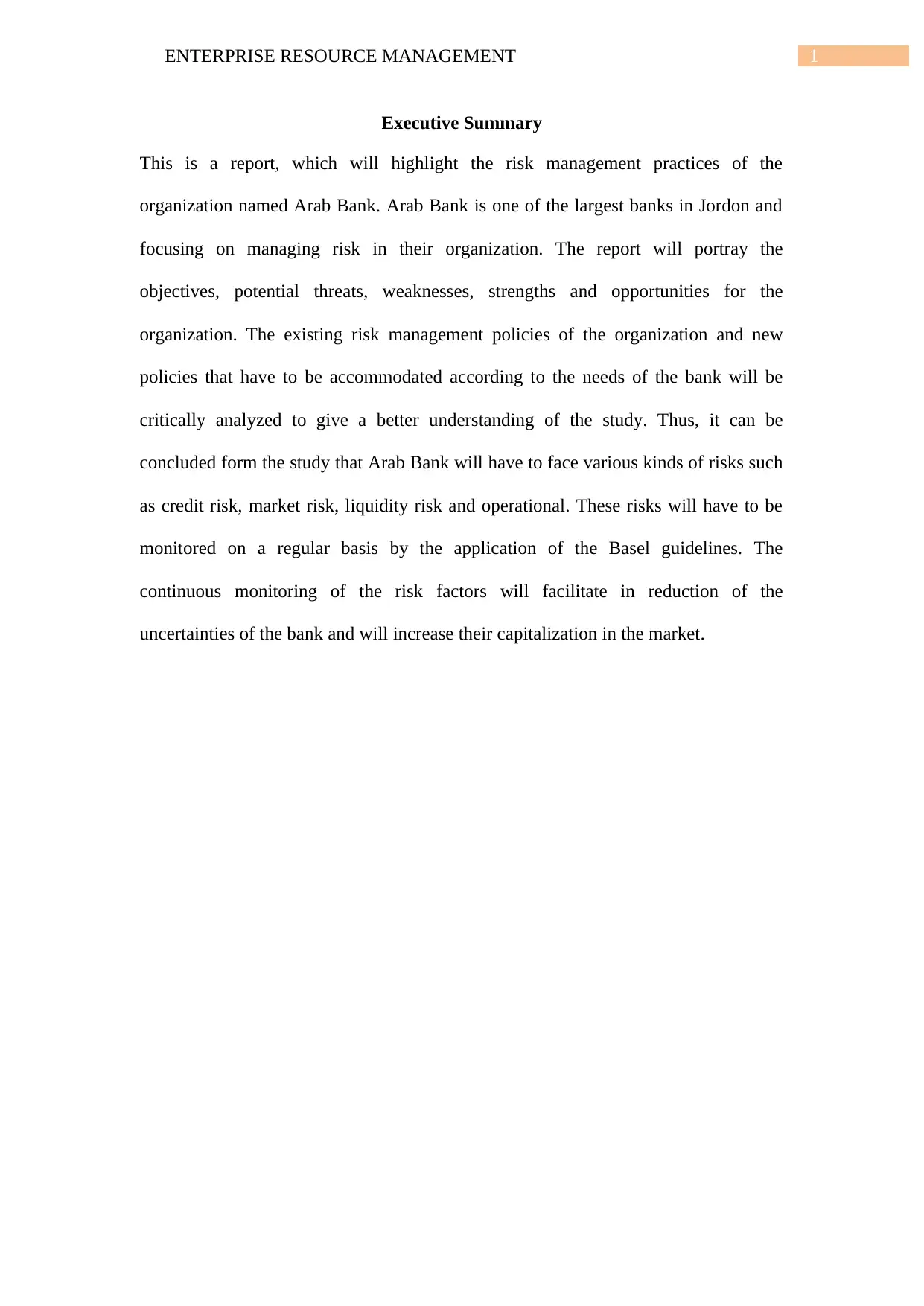
1ENTERPRISE RESOURCE MANAGEMENT
Executive Summary
This is a report, which will highlight the risk management practices of the
organization named Arab Bank. Arab Bank is one of the largest banks in Jordon and
focusing on managing risk in their organization. The report will portray the
objectives, potential threats, weaknesses, strengths and opportunities for the
organization. The existing risk management policies of the organization and new
policies that have to be accommodated according to the needs of the bank will be
critically analyzed to give a better understanding of the study. Thus, it can be
concluded form the study that Arab Bank will have to face various kinds of risks such
as credit risk, market risk, liquidity risk and operational. These risks will have to be
monitored on a regular basis by the application of the Basel guidelines. The
continuous monitoring of the risk factors will facilitate in reduction of the
uncertainties of the bank and will increase their capitalization in the market.
Executive Summary
This is a report, which will highlight the risk management practices of the
organization named Arab Bank. Arab Bank is one of the largest banks in Jordon and
focusing on managing risk in their organization. The report will portray the
objectives, potential threats, weaknesses, strengths and opportunities for the
organization. The existing risk management policies of the organization and new
policies that have to be accommodated according to the needs of the bank will be
critically analyzed to give a better understanding of the study. Thus, it can be
concluded form the study that Arab Bank will have to face various kinds of risks such
as credit risk, market risk, liquidity risk and operational. These risks will have to be
monitored on a regular basis by the application of the Basel guidelines. The
continuous monitoring of the risk factors will facilitate in reduction of the
uncertainties of the bank and will increase their capitalization in the market.

2ENTERPRISE RESOURCE MANAGEMENT
Table of Contents
Introduction....................................................................................................................3
Background....................................................................................................................3
Aims of organisation......................................................................................................3
Identified threats and opportunities................................................................................5
Risk management practices............................................................................................6
Risk register.................................................................................................................11
Calculation of risk and risk threshold..........................................................................14
Mitigation actions.........................................................................................................17
Conclusion....................................................................................................................17
References....................................................................................................................18
Table of Contents
Introduction....................................................................................................................3
Background....................................................................................................................3
Aims of organisation......................................................................................................3
Identified threats and opportunities................................................................................5
Risk management practices............................................................................................6
Risk register.................................................................................................................11
Calculation of risk and risk threshold..........................................................................14
Mitigation actions.........................................................................................................17
Conclusion....................................................................................................................17
References....................................................................................................................18
⊘ This is a preview!⊘
Do you want full access?
Subscribe today to unlock all pages.

Trusted by 1+ million students worldwide

3ENTERPRISE RESOURCE MANAGEMENT
Introduction
This is a report, which will highlight the risk management practices of the
organization named Arab Bank. Arab Bank is one of the largest banks in Jordon and
focusing on managing risk in their organization. The report will portray the
objectives, potential threats, weaknesses, strengths and opportunities for the
organization. The existing risk management policies of the organization and new
policies that have to be accommodated according to the needs of the bank will be
critically analyzed to give a better understanding of the study.
Background
Arab Bank is one of the largest financial institutions in the Middle East and
belongs to the private sector. Arab Bank has its headquarters in Amman, which is
situated in Jordon. The organization has been catering to large number of consumers
over 600 branches, which are spread in five continents. Arab Bank is one of the major
economic contributors in Jordon as they provide banking solutions to their clients and
at the same time facilitates in development of business growth (Arabbank.jo 2017).
The organization has grabbed the majority of stakes and has highest capitalization in
the market. The bank faced some issues right after the global economic crisis, which
lead to the decrease in the credit rating of the organization. However, they have been
able to bounce back and regain their strong hold in the market.
Aims of organisation
The political instability of the Arab countries is increasing the amount of risk
in the market. The bank is aiming to incorporate strong information technology
systems, efficient governance and employment of workforce, which are highly skilled
Introduction
This is a report, which will highlight the risk management practices of the
organization named Arab Bank. Arab Bank is one of the largest banks in Jordon and
focusing on managing risk in their organization. The report will portray the
objectives, potential threats, weaknesses, strengths and opportunities for the
organization. The existing risk management policies of the organization and new
policies that have to be accommodated according to the needs of the bank will be
critically analyzed to give a better understanding of the study.
Background
Arab Bank is one of the largest financial institutions in the Middle East and
belongs to the private sector. Arab Bank has its headquarters in Amman, which is
situated in Jordon. The organization has been catering to large number of consumers
over 600 branches, which are spread in five continents. Arab Bank is one of the major
economic contributors in Jordon as they provide banking solutions to their clients and
at the same time facilitates in development of business growth (Arabbank.jo 2017).
The organization has grabbed the majority of stakes and has highest capitalization in
the market. The bank faced some issues right after the global economic crisis, which
lead to the decrease in the credit rating of the organization. However, they have been
able to bounce back and regain their strong hold in the market.
Aims of organisation
The political instability of the Arab countries is increasing the amount of risk
in the market. The bank is aiming to incorporate strong information technology
systems, efficient governance and employment of workforce, which are highly skilled
Paraphrase This Document
Need a fresh take? Get an instant paraphrase of this document with our AI Paraphraser

4ENTERPRISE RESOURCE MANAGEMENT
(Arabbank.jo 2017). Thus, the organization will have to prioritize the risk issues; this
will enable to include flexibility within the risk structure of the organization. Arab
Bank has its own set of values and principles that are developed based on the interest
of the stakeholders. The values are as follows:
Commitment: The organization has aimed to support economies and the
people in that region.
Trust: Arab Bank has been able to successfully protect the customer interest,
they have kept a secured network and maintains confidentiality of the client
data.
Citizenship: The organization has been involved in corporate social activities
by nurturing advancement and growth of the industry and the people. Arab
Bank has been able to contribute to the overall development of the society.
Customer Focus: The bank is focused on fulfilling the needs of the
organization.
Service Excellence: Customer experience management has been incorporated
in to the business model of the organization, which has facilitated in providing
extraordinary service by improving the experience of the customer.
Teamwork: The work culture is based on teamwork and the organization
provides encouragement in making efforts of collaboration.
Empowerment: The organization had aimed to provide effective training and
development program for the workforce. This will enable the workforce to
grow personally and professionally at the same time.
Transparency: The organization has tried to keep the communication with the
consumers as open as possible so that they can maintain the transparency of
the processes and gain their trust.
(Arabbank.jo 2017). Thus, the organization will have to prioritize the risk issues; this
will enable to include flexibility within the risk structure of the organization. Arab
Bank has its own set of values and principles that are developed based on the interest
of the stakeholders. The values are as follows:
Commitment: The organization has aimed to support economies and the
people in that region.
Trust: Arab Bank has been able to successfully protect the customer interest,
they have kept a secured network and maintains confidentiality of the client
data.
Citizenship: The organization has been involved in corporate social activities
by nurturing advancement and growth of the industry and the people. Arab
Bank has been able to contribute to the overall development of the society.
Customer Focus: The bank is focused on fulfilling the needs of the
organization.
Service Excellence: Customer experience management has been incorporated
in to the business model of the organization, which has facilitated in providing
extraordinary service by improving the experience of the customer.
Teamwork: The work culture is based on teamwork and the organization
provides encouragement in making efforts of collaboration.
Empowerment: The organization had aimed to provide effective training and
development program for the workforce. This will enable the workforce to
grow personally and professionally at the same time.
Transparency: The organization has tried to keep the communication with the
consumers as open as possible so that they can maintain the transparency of
the processes and gain their trust.

5ENTERPRISE RESOURCE MANAGEMENT
Identified threats and opportunities
STP
Segment Corporate banking, Private banking, Loans, commercial
lending, Structured finance, Project Finance, Savings
account and current account.
Target Group Various business organizations and corporate individual
who are in need of financial services
Positioning A financial institution, which maintains transparency and
be a responsible corporate citizen
SWOT Analysis
Strengths Globally established in five continents
Major contributor to economy
Good awareness
Asset base is huge
One of the largest financial institutions
Weaknesses Involvement in controversies which has
affected the global image of the brand
Opportunities Demand of banking services in the Middle
East is booming in nature
Opportunity of forming alliances, which will
facilitate in penetration in international
market
Threats Increase in competition in the Middle East
market
Identified threats and opportunities
STP
Segment Corporate banking, Private banking, Loans, commercial
lending, Structured finance, Project Finance, Savings
account and current account.
Target Group Various business organizations and corporate individual
who are in need of financial services
Positioning A financial institution, which maintains transparency and
be a responsible corporate citizen
SWOT Analysis
Strengths Globally established in five continents
Major contributor to economy
Good awareness
Asset base is huge
One of the largest financial institutions
Weaknesses Involvement in controversies which has
affected the global image of the brand
Opportunities Demand of banking services in the Middle
East is booming in nature
Opportunity of forming alliances, which will
facilitate in penetration in international
market
Threats Increase in competition in the Middle East
market
⊘ This is a preview!⊘
Do you want full access?
Subscribe today to unlock all pages.

Trusted by 1+ million students worldwide
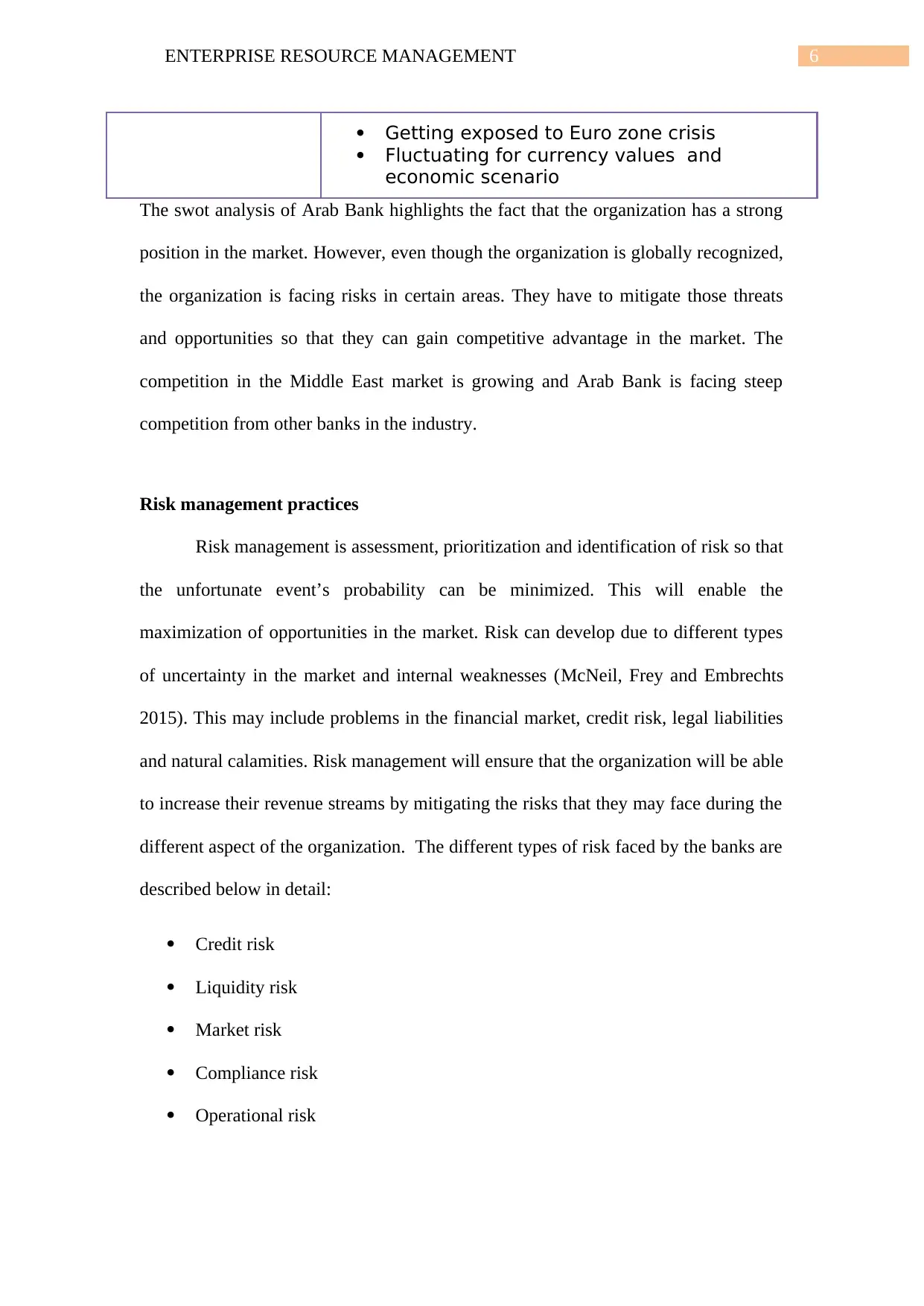
6ENTERPRISE RESOURCE MANAGEMENT
Getting exposed to Euro zone crisis
Fluctuating for currency values and
economic scenario
The swot analysis of Arab Bank highlights the fact that the organization has a strong
position in the market. However, even though the organization is globally recognized,
the organization is facing risks in certain areas. They have to mitigate those threats
and opportunities so that they can gain competitive advantage in the market. The
competition in the Middle East market is growing and Arab Bank is facing steep
competition from other banks in the industry.
Risk management practices
Risk management is assessment, prioritization and identification of risk so that
the unfortunate event’s probability can be minimized. This will enable the
maximization of opportunities in the market. Risk can develop due to different types
of uncertainty in the market and internal weaknesses (McNeil, Frey and Embrechts
2015). This may include problems in the financial market, credit risk, legal liabilities
and natural calamities. Risk management will ensure that the organization will be able
to increase their revenue streams by mitigating the risks that they may face during the
different aspect of the organization. The different types of risk faced by the banks are
described below in detail:
Credit risk
Liquidity risk
Market risk
Compliance risk
Operational risk
Getting exposed to Euro zone crisis
Fluctuating for currency values and
economic scenario
The swot analysis of Arab Bank highlights the fact that the organization has a strong
position in the market. However, even though the organization is globally recognized,
the organization is facing risks in certain areas. They have to mitigate those threats
and opportunities so that they can gain competitive advantage in the market. The
competition in the Middle East market is growing and Arab Bank is facing steep
competition from other banks in the industry.
Risk management practices
Risk management is assessment, prioritization and identification of risk so that
the unfortunate event’s probability can be minimized. This will enable the
maximization of opportunities in the market. Risk can develop due to different types
of uncertainty in the market and internal weaknesses (McNeil, Frey and Embrechts
2015). This may include problems in the financial market, credit risk, legal liabilities
and natural calamities. Risk management will ensure that the organization will be able
to increase their revenue streams by mitigating the risks that they may face during the
different aspect of the organization. The different types of risk faced by the banks are
described below in detail:
Credit risk
Liquidity risk
Market risk
Compliance risk
Operational risk
Paraphrase This Document
Need a fresh take? Get an instant paraphrase of this document with our AI Paraphraser
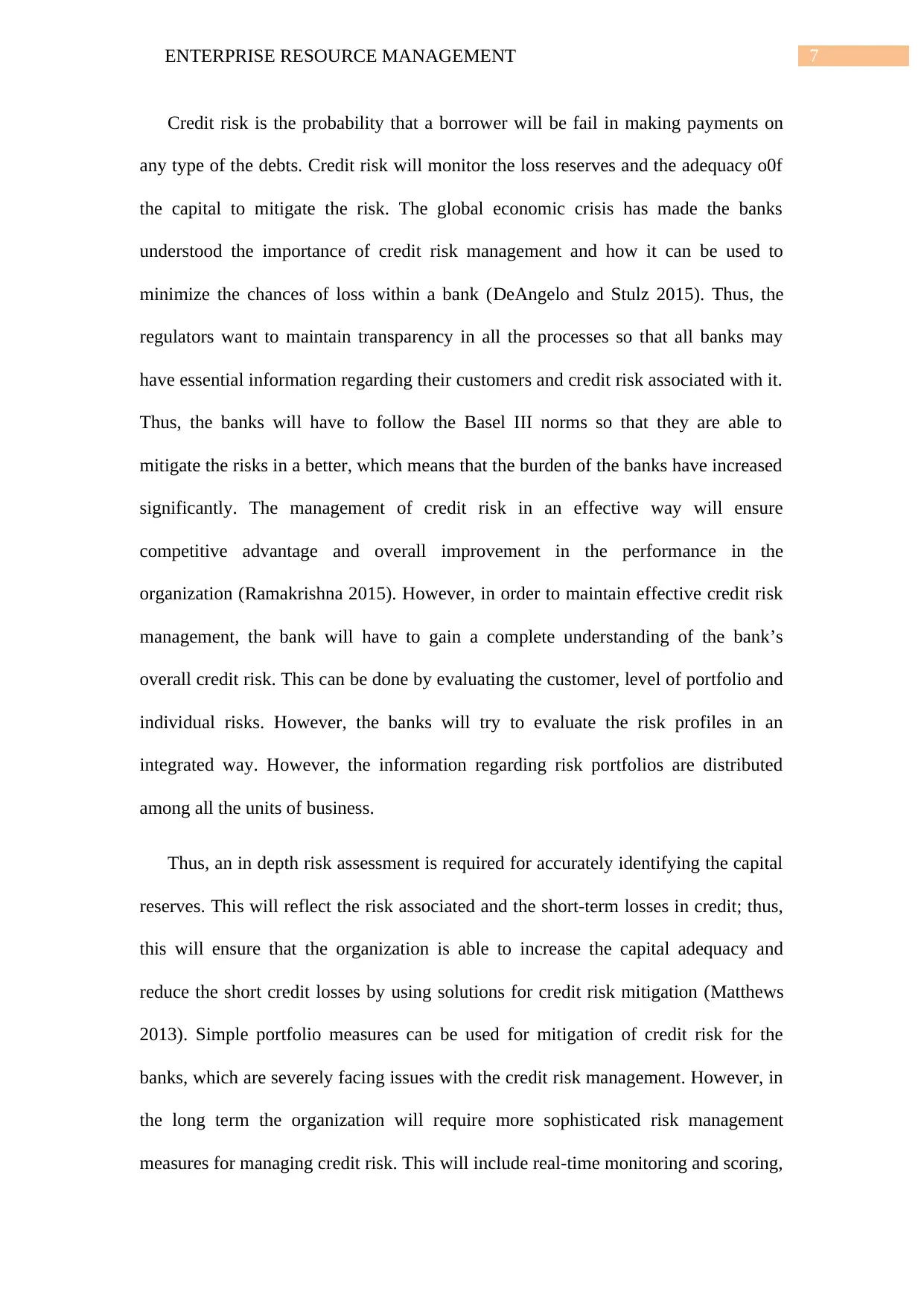
7ENTERPRISE RESOURCE MANAGEMENT
Credit risk is the probability that a borrower will be fail in making payments on
any type of the debts. Credit risk will monitor the loss reserves and the adequacy o0f
the capital to mitigate the risk. The global economic crisis has made the banks
understood the importance of credit risk management and how it can be used to
minimize the chances of loss within a bank (DeAngelo and Stulz 2015). Thus, the
regulators want to maintain transparency in all the processes so that all banks may
have essential information regarding their customers and credit risk associated with it.
Thus, the banks will have to follow the Basel III norms so that they are able to
mitigate the risks in a better, which means that the burden of the banks have increased
significantly. The management of credit risk in an effective way will ensure
competitive advantage and overall improvement in the performance in the
organization (Ramakrishna 2015). However, in order to maintain effective credit risk
management, the bank will have to gain a complete understanding of the bank’s
overall credit risk. This can be done by evaluating the customer, level of portfolio and
individual risks. However, the banks will try to evaluate the risk profiles in an
integrated way. However, the information regarding risk portfolios are distributed
among all the units of business.
Thus, an in depth risk assessment is required for accurately identifying the capital
reserves. This will reflect the risk associated and the short-term losses in credit; thus,
this will ensure that the organization is able to increase the capital adequacy and
reduce the short credit losses by using solutions for credit risk mitigation (Matthews
2013). Simple portfolio measures can be used for mitigation of credit risk for the
banks, which are severely facing issues with the credit risk management. However, in
the long term the organization will require more sophisticated risk management
measures for managing credit risk. This will include real-time monitoring and scoring,
Credit risk is the probability that a borrower will be fail in making payments on
any type of the debts. Credit risk will monitor the loss reserves and the adequacy o0f
the capital to mitigate the risk. The global economic crisis has made the banks
understood the importance of credit risk management and how it can be used to
minimize the chances of loss within a bank (DeAngelo and Stulz 2015). Thus, the
regulators want to maintain transparency in all the processes so that all banks may
have essential information regarding their customers and credit risk associated with it.
Thus, the banks will have to follow the Basel III norms so that they are able to
mitigate the risks in a better, which means that the burden of the banks have increased
significantly. The management of credit risk in an effective way will ensure
competitive advantage and overall improvement in the performance in the
organization (Ramakrishna 2015). However, in order to maintain effective credit risk
management, the bank will have to gain a complete understanding of the bank’s
overall credit risk. This can be done by evaluating the customer, level of portfolio and
individual risks. However, the banks will try to evaluate the risk profiles in an
integrated way. However, the information regarding risk portfolios are distributed
among all the units of business.
Thus, an in depth risk assessment is required for accurately identifying the capital
reserves. This will reflect the risk associated and the short-term losses in credit; thus,
this will ensure that the organization is able to increase the capital adequacy and
reduce the short credit losses by using solutions for credit risk mitigation (Matthews
2013). Simple portfolio measures can be used for mitigation of credit risk for the
banks, which are severely facing issues with the credit risk management. However, in
the long term the organization will require more sophisticated risk management
measures for managing credit risk. This will include real-time monitoring and scoring,
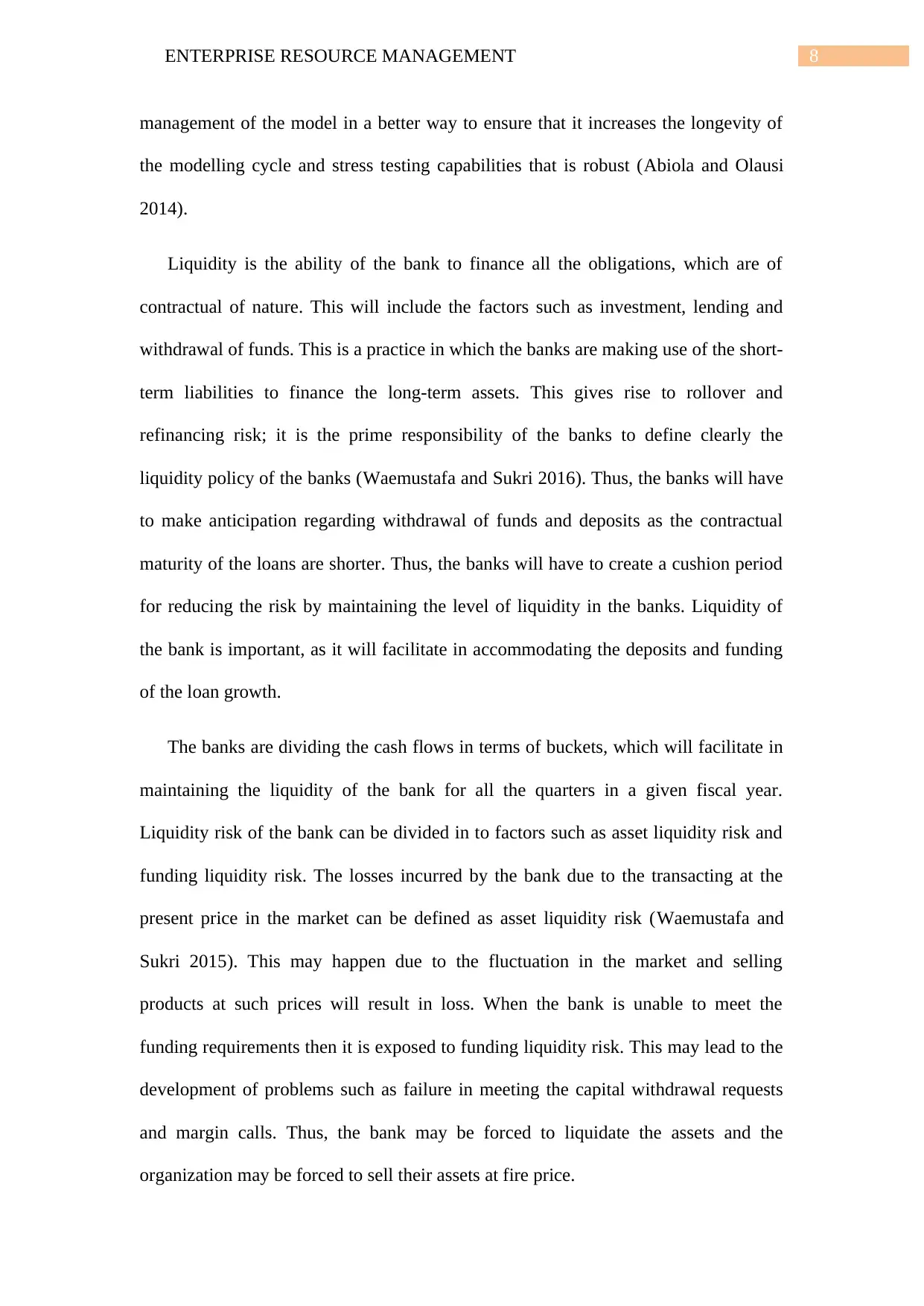
8ENTERPRISE RESOURCE MANAGEMENT
management of the model in a better way to ensure that it increases the longevity of
the modelling cycle and stress testing capabilities that is robust (Abiola and Olausi
2014).
Liquidity is the ability of the bank to finance all the obligations, which are of
contractual of nature. This will include the factors such as investment, lending and
withdrawal of funds. This is a practice in which the banks are making use of the short-
term liabilities to finance the long-term assets. This gives rise to rollover and
refinancing risk; it is the prime responsibility of the banks to define clearly the
liquidity policy of the banks (Waemustafa and Sukri 2016). Thus, the banks will have
to make anticipation regarding withdrawal of funds and deposits as the contractual
maturity of the loans are shorter. Thus, the banks will have to create a cushion period
for reducing the risk by maintaining the level of liquidity in the banks. Liquidity of
the bank is important, as it will facilitate in accommodating the deposits and funding
of the loan growth.
The banks are dividing the cash flows in terms of buckets, which will facilitate in
maintaining the liquidity of the bank for all the quarters in a given fiscal year.
Liquidity risk of the bank can be divided in to factors such as asset liquidity risk and
funding liquidity risk. The losses incurred by the bank due to the transacting at the
present price in the market can be defined as asset liquidity risk (Waemustafa and
Sukri 2015). This may happen due to the fluctuation in the market and selling
products at such prices will result in loss. When the bank is unable to meet the
funding requirements then it is exposed to funding liquidity risk. This may lead to the
development of problems such as failure in meeting the capital withdrawal requests
and margin calls. Thus, the bank may be forced to liquidate the assets and the
organization may be forced to sell their assets at fire price.
management of the model in a better way to ensure that it increases the longevity of
the modelling cycle and stress testing capabilities that is robust (Abiola and Olausi
2014).
Liquidity is the ability of the bank to finance all the obligations, which are of
contractual of nature. This will include the factors such as investment, lending and
withdrawal of funds. This is a practice in which the banks are making use of the short-
term liabilities to finance the long-term assets. This gives rise to rollover and
refinancing risk; it is the prime responsibility of the banks to define clearly the
liquidity policy of the banks (Waemustafa and Sukri 2016). Thus, the banks will have
to make anticipation regarding withdrawal of funds and deposits as the contractual
maturity of the loans are shorter. Thus, the banks will have to create a cushion period
for reducing the risk by maintaining the level of liquidity in the banks. Liquidity of
the bank is important, as it will facilitate in accommodating the deposits and funding
of the loan growth.
The banks are dividing the cash flows in terms of buckets, which will facilitate in
maintaining the liquidity of the bank for all the quarters in a given fiscal year.
Liquidity risk of the bank can be divided in to factors such as asset liquidity risk and
funding liquidity risk. The losses incurred by the bank due to the transacting at the
present price in the market can be defined as asset liquidity risk (Waemustafa and
Sukri 2015). This may happen due to the fluctuation in the market and selling
products at such prices will result in loss. When the bank is unable to meet the
funding requirements then it is exposed to funding liquidity risk. This may lead to the
development of problems such as failure in meeting the capital withdrawal requests
and margin calls. Thus, the bank may be forced to liquidate the assets and the
organization may be forced to sell their assets at fire price.
⊘ This is a preview!⊘
Do you want full access?
Subscribe today to unlock all pages.

Trusted by 1+ million students worldwide
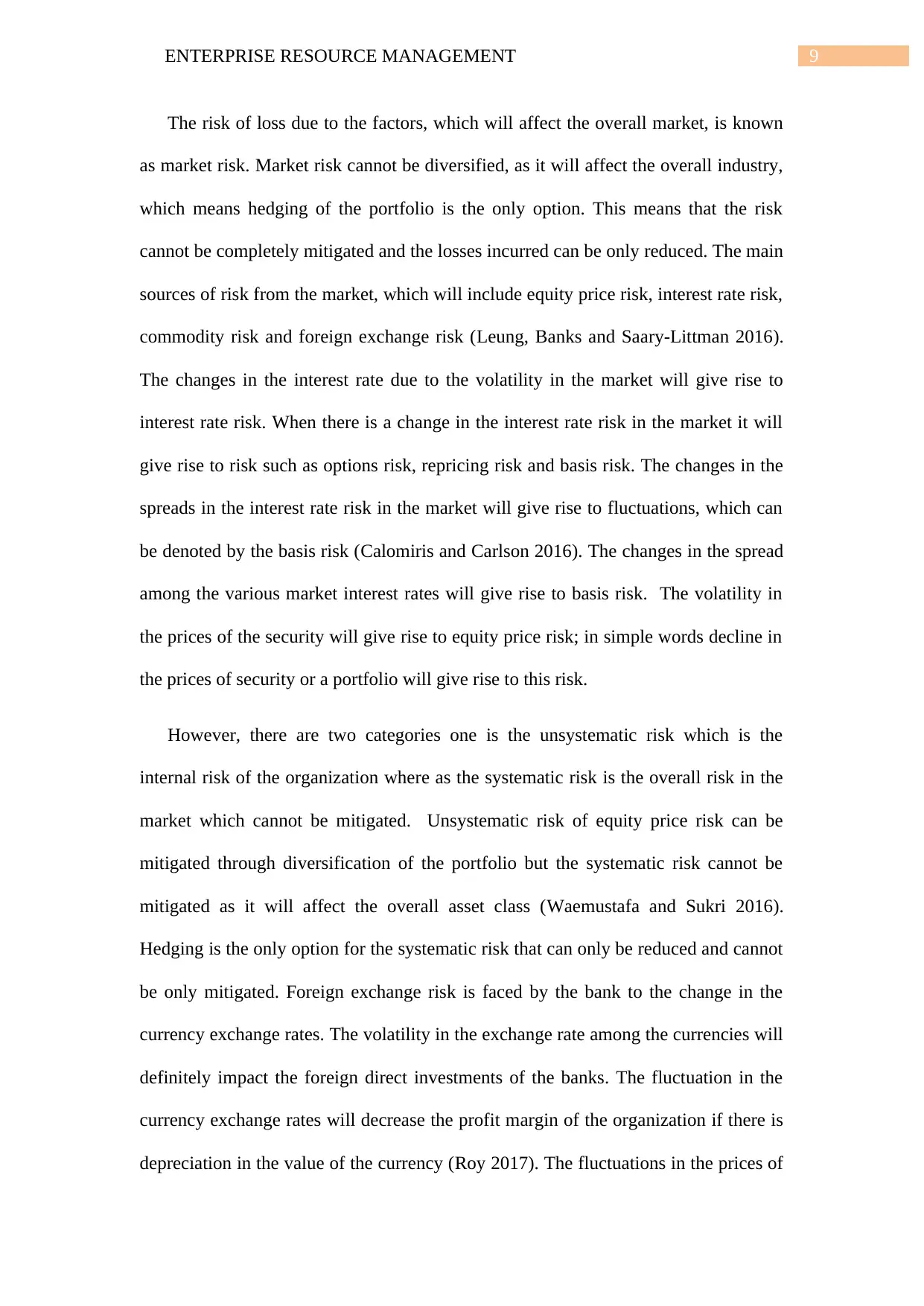
9ENTERPRISE RESOURCE MANAGEMENT
The risk of loss due to the factors, which will affect the overall market, is known
as market risk. Market risk cannot be diversified, as it will affect the overall industry,
which means hedging of the portfolio is the only option. This means that the risk
cannot be completely mitigated and the losses incurred can be only reduced. The main
sources of risk from the market, which will include equity price risk, interest rate risk,
commodity risk and foreign exchange risk (Leung, Banks and Saary-Littman 2016).
The changes in the interest rate due to the volatility in the market will give rise to
interest rate risk. When there is a change in the interest rate risk in the market it will
give rise to risk such as options risk, repricing risk and basis risk. The changes in the
spreads in the interest rate risk in the market will give rise to fluctuations, which can
be denoted by the basis risk (Calomiris and Carlson 2016). The changes in the spread
among the various market interest rates will give rise to basis risk. The volatility in
the prices of the security will give rise to equity price risk; in simple words decline in
the prices of security or a portfolio will give rise to this risk.
However, there are two categories one is the unsystematic risk which is the
internal risk of the organization where as the systematic risk is the overall risk in the
market which cannot be mitigated. Unsystematic risk of equity price risk can be
mitigated through diversification of the portfolio but the systematic risk cannot be
mitigated as it will affect the overall asset class (Waemustafa and Sukri 2016).
Hedging is the only option for the systematic risk that can only be reduced and cannot
be only mitigated. Foreign exchange risk is faced by the bank to the change in the
currency exchange rates. The volatility in the exchange rate among the currencies will
definitely impact the foreign direct investments of the banks. The fluctuation in the
currency exchange rates will decrease the profit margin of the organization if there is
depreciation in the value of the currency (Roy 2017). The fluctuations in the prices of
The risk of loss due to the factors, which will affect the overall market, is known
as market risk. Market risk cannot be diversified, as it will affect the overall industry,
which means hedging of the portfolio is the only option. This means that the risk
cannot be completely mitigated and the losses incurred can be only reduced. The main
sources of risk from the market, which will include equity price risk, interest rate risk,
commodity risk and foreign exchange risk (Leung, Banks and Saary-Littman 2016).
The changes in the interest rate due to the volatility in the market will give rise to
interest rate risk. When there is a change in the interest rate risk in the market it will
give rise to risk such as options risk, repricing risk and basis risk. The changes in the
spreads in the interest rate risk in the market will give rise to fluctuations, which can
be denoted by the basis risk (Calomiris and Carlson 2016). The changes in the spread
among the various market interest rates will give rise to basis risk. The volatility in
the prices of the security will give rise to equity price risk; in simple words decline in
the prices of security or a portfolio will give rise to this risk.
However, there are two categories one is the unsystematic risk which is the
internal risk of the organization where as the systematic risk is the overall risk in the
market which cannot be mitigated. Unsystematic risk of equity price risk can be
mitigated through diversification of the portfolio but the systematic risk cannot be
mitigated as it will affect the overall asset class (Waemustafa and Sukri 2016).
Hedging is the only option for the systematic risk that can only be reduced and cannot
be only mitigated. Foreign exchange risk is faced by the bank to the change in the
currency exchange rates. The volatility in the exchange rate among the currencies will
definitely impact the foreign direct investments of the banks. The fluctuation in the
currency exchange rates will decrease the profit margin of the organization if there is
depreciation in the value of the currency (Roy 2017). The fluctuations in the prices of
Paraphrase This Document
Need a fresh take? Get an instant paraphrase of this document with our AI Paraphraser
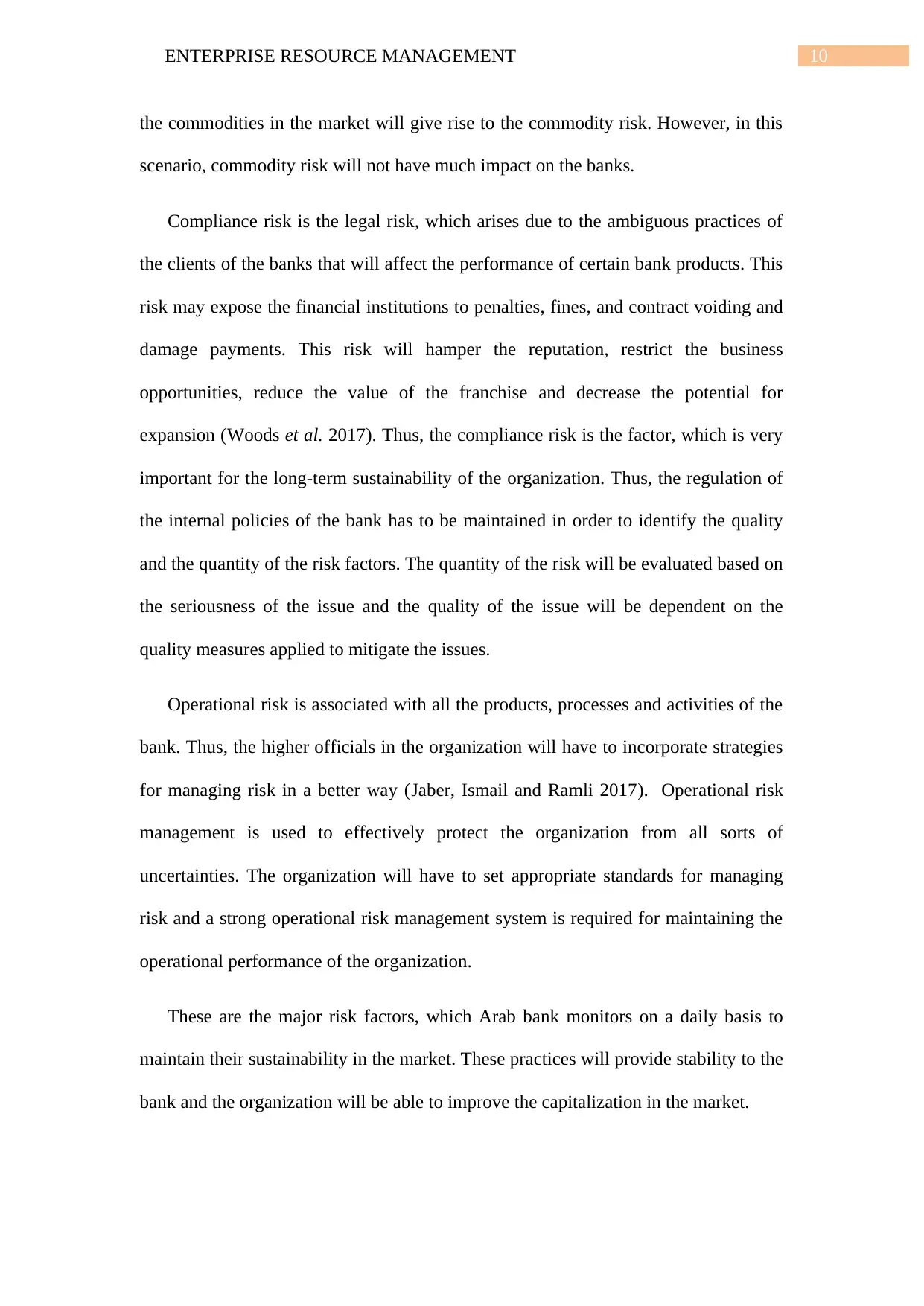
10ENTERPRISE RESOURCE MANAGEMENT
the commodities in the market will give rise to the commodity risk. However, in this
scenario, commodity risk will not have much impact on the banks.
Compliance risk is the legal risk, which arises due to the ambiguous practices of
the clients of the banks that will affect the performance of certain bank products. This
risk may expose the financial institutions to penalties, fines, and contract voiding and
damage payments. This risk will hamper the reputation, restrict the business
opportunities, reduce the value of the franchise and decrease the potential for
expansion (Woods et al. 2017). Thus, the compliance risk is the factor, which is very
important for the long-term sustainability of the organization. Thus, the regulation of
the internal policies of the bank has to be maintained in order to identify the quality
and the quantity of the risk factors. The quantity of the risk will be evaluated based on
the seriousness of the issue and the quality of the issue will be dependent on the
quality measures applied to mitigate the issues.
Operational risk is associated with all the products, processes and activities of the
bank. Thus, the higher officials in the organization will have to incorporate strategies
for managing risk in a better way (Jaber, Ismail and Ramli 2017). Operational risk
management is used to effectively protect the organization from all sorts of
uncertainties. The organization will have to set appropriate standards for managing
risk and a strong operational risk management system is required for maintaining the
operational performance of the organization.
These are the major risk factors, which Arab bank monitors on a daily basis to
maintain their sustainability in the market. These practices will provide stability to the
bank and the organization will be able to improve the capitalization in the market.
the commodities in the market will give rise to the commodity risk. However, in this
scenario, commodity risk will not have much impact on the banks.
Compliance risk is the legal risk, which arises due to the ambiguous practices of
the clients of the banks that will affect the performance of certain bank products. This
risk may expose the financial institutions to penalties, fines, and contract voiding and
damage payments. This risk will hamper the reputation, restrict the business
opportunities, reduce the value of the franchise and decrease the potential for
expansion (Woods et al. 2017). Thus, the compliance risk is the factor, which is very
important for the long-term sustainability of the organization. Thus, the regulation of
the internal policies of the bank has to be maintained in order to identify the quality
and the quantity of the risk factors. The quantity of the risk will be evaluated based on
the seriousness of the issue and the quality of the issue will be dependent on the
quality measures applied to mitigate the issues.
Operational risk is associated with all the products, processes and activities of the
bank. Thus, the higher officials in the organization will have to incorporate strategies
for managing risk in a better way (Jaber, Ismail and Ramli 2017). Operational risk
management is used to effectively protect the organization from all sorts of
uncertainties. The organization will have to set appropriate standards for managing
risk and a strong operational risk management system is required for maintaining the
operational performance of the organization.
These are the major risk factors, which Arab bank monitors on a daily basis to
maintain their sustainability in the market. These practices will provide stability to the
bank and the organization will be able to improve the capitalization in the market.
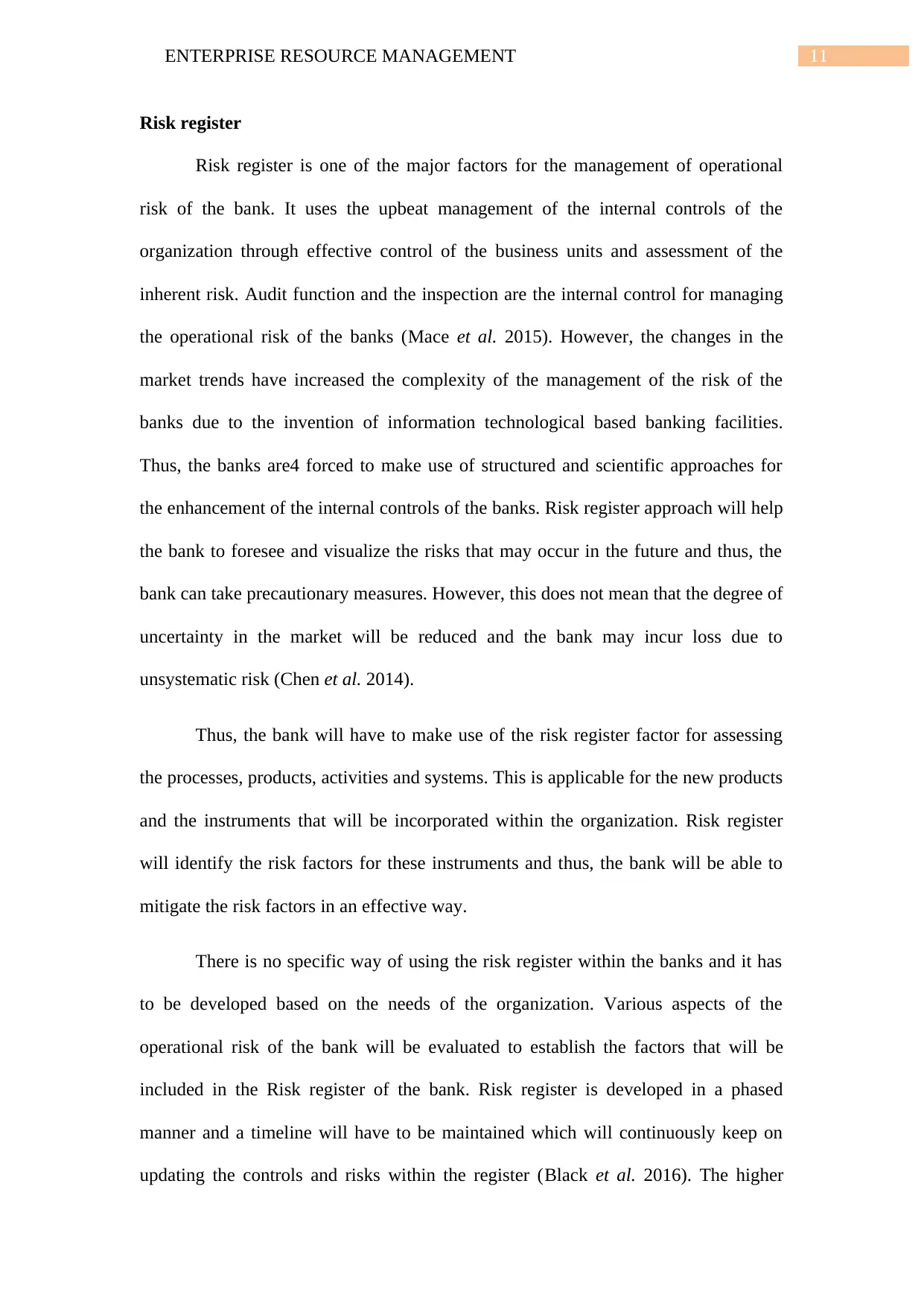
11ENTERPRISE RESOURCE MANAGEMENT
Risk register
Risk register is one of the major factors for the management of operational
risk of the bank. It uses the upbeat management of the internal controls of the
organization through effective control of the business units and assessment of the
inherent risk. Audit function and the inspection are the internal control for managing
the operational risk of the banks (Mace et al. 2015). However, the changes in the
market trends have increased the complexity of the management of the risk of the
banks due to the invention of information technological based banking facilities.
Thus, the banks are4 forced to make use of structured and scientific approaches for
the enhancement of the internal controls of the banks. Risk register approach will help
the bank to foresee and visualize the risks that may occur in the future and thus, the
bank can take precautionary measures. However, this does not mean that the degree of
uncertainty in the market will be reduced and the bank may incur loss due to
unsystematic risk (Chen et al. 2014).
Thus, the bank will have to make use of the risk register factor for assessing
the processes, products, activities and systems. This is applicable for the new products
and the instruments that will be incorporated within the organization. Risk register
will identify the risk factors for these instruments and thus, the bank will be able to
mitigate the risk factors in an effective way.
There is no specific way of using the risk register within the banks and it has
to be developed based on the needs of the organization. Various aspects of the
operational risk of the bank will be evaluated to establish the factors that will be
included in the Risk register of the bank. Risk register is developed in a phased
manner and a timeline will have to be maintained which will continuously keep on
updating the controls and risks within the register (Black et al. 2016). The higher
Risk register
Risk register is one of the major factors for the management of operational
risk of the bank. It uses the upbeat management of the internal controls of the
organization through effective control of the business units and assessment of the
inherent risk. Audit function and the inspection are the internal control for managing
the operational risk of the banks (Mace et al. 2015). However, the changes in the
market trends have increased the complexity of the management of the risk of the
banks due to the invention of information technological based banking facilities.
Thus, the banks are4 forced to make use of structured and scientific approaches for
the enhancement of the internal controls of the banks. Risk register approach will help
the bank to foresee and visualize the risks that may occur in the future and thus, the
bank can take precautionary measures. However, this does not mean that the degree of
uncertainty in the market will be reduced and the bank may incur loss due to
unsystematic risk (Chen et al. 2014).
Thus, the bank will have to make use of the risk register factor for assessing
the processes, products, activities and systems. This is applicable for the new products
and the instruments that will be incorporated within the organization. Risk register
will identify the risk factors for these instruments and thus, the bank will be able to
mitigate the risk factors in an effective way.
There is no specific way of using the risk register within the banks and it has
to be developed based on the needs of the organization. Various aspects of the
operational risk of the bank will be evaluated to establish the factors that will be
included in the Risk register of the bank. Risk register is developed in a phased
manner and a timeline will have to be maintained which will continuously keep on
updating the controls and risks within the register (Black et al. 2016). The higher
⊘ This is a preview!⊘
Do you want full access?
Subscribe today to unlock all pages.

Trusted by 1+ million students worldwide
1 out of 21
Related Documents
Your All-in-One AI-Powered Toolkit for Academic Success.
+13062052269
info@desklib.com
Available 24*7 on WhatsApp / Email
![[object Object]](/_next/static/media/star-bottom.7253800d.svg)
Unlock your academic potential
Copyright © 2020–2025 A2Z Services. All Rights Reserved. Developed and managed by ZUCOL.





